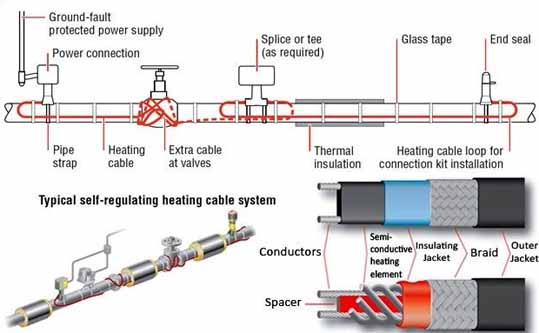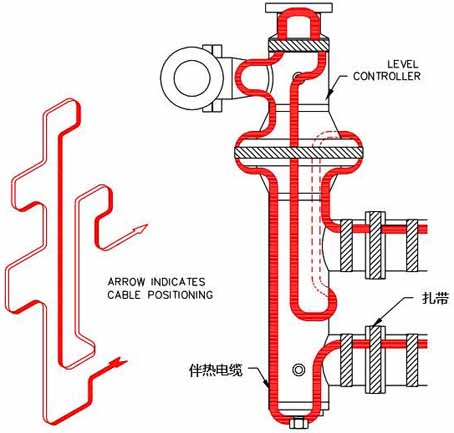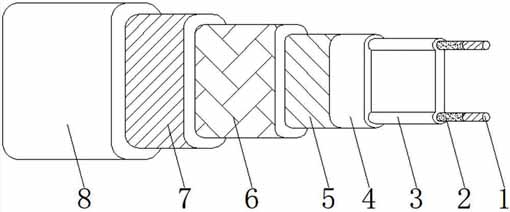Precautions for the Use of Heating Cables

Installation and construction of electric heating cable
Installation and construction is the key to good use of heating cables. Read carefully before installation and a professional electrician is responsible. Installation construction is roughly divided into:1. Confirm whether the installation conditions are met;
2. Install heating cables and terminals;
3. Install the power supply box;
4. Measure insulation resistance;
5. Connect the power supply and switch;
6. Power-on experiment;
7. Make the mark of electric heat tracing;
8. Repeat steps 4 and 6;
9. Do heat preservation and waterproofing;
10. Inspection and acceptance.

Installation conditions
The installation of the electric heating cable should be carried out after the main project is completed, that is, no welding, hoisting, etc. will be carried out above the installation place of the heating cable to avoid damage to the cable. Confirm that the pipeline or equipment that needs heating has been tested for leaks, cleaned, and the burrs, sharp or edge-like protrusions on the surface have been polished and smooth.
Electrical connections
1. The connection between the heating cable and the power box: In flammable and explosive situations, a matching explosion-proof power junction box must be used. In general occasions, the heating cable can be directly connected to the knife switch, or the wires can be twisted or welded and sealed with quick-drying silicone and heat shrinkable tubing. The spliced joint shall not be shorter than 30mm, and the welded joint shall not be shorter than 10mm.
2. Bifurcation of heating cable: In flammable and explosive occasions, a matching explosion-proof straight junction box must be used, and in general occasions, splicing or welding can also be used.
3. Connection length of heating cable: In flammable and explosive occasions, a matching explosion-proof straight junction box must be used, and in general occasions, splicing or welding can also be used. When increasing the length, please be careful not to exceed the maximum use length.
4. Terminal: In flammable and explosive situations, a matching terminal sealing box must be used. In general occasions, fast silica gel and heat shrinkable tubing can also be used for sealing. It is strictly forbidden to connect the tail cores under any circumstances.
5. Junction box of power supply: For T-type and straight-type junction boxes, the terminals can be fastened to the pipe with clamps or nylon cable ties. The waterproof rubber pad in the box shall not be omitted, and the wiring part in the box shall be waterproofed with quick-drying silica gel. When doing heat preservation, the junction box should be placed in the heat preservation layer, but the corresponding mark must be left on the heat preservation layer.
Insulation layer and waterproof layer
The insulation layer and waterproof layer are an important part of the heating cable system. It must be installed in strict accordance with the design requirements, especially outdoors. Once rainwater penetrates into the layer, the thermal insulation capacity will be greatly reduced. If the protective cover is damaged, it may cause electric breakdown, spark or dark fire. Therefore, it is necessary to strengthen on-site management to prevent construction personnel from unintentionally damaging the heating cables. After the insulation test is qualified, the insulation layer and waterproof layer should be installed as soon as possible. During installation, the metal sheet should be prevented from cutting the outer sheath of the heating cable.
Installation of heating cable control alarm box
① According to the location of the power distribution room;
② Does not affect the installation of other electrical equipment;
③ The wall to be installed is a solid wall, and the ceramsite or hollow brick wall should be equipped with brackets;
④ The principle of high and low position is better for easy observation and maintenance. Based on the above positioning principle and the pipeline layout of the electric heating system, a two-wire heating cable is used to control the alarm box. They are respectively placed in the power distribution room or duty room on both sides of the platform, and 220V voltage is supplied to the control box from the power distribution box in the power distribution room. Each heating cable control box is connected with 2 double-conducting heating cables. The heating control alarm box must be installed strictly according to the design requirements.
The installation height and vertical error of the cabinet shall be controlled within the allowable range of the specification. The wiring in the box should be neat and beautiful, in a reasonable direction, tied into a bundle and properly fixed. The connection between the wire and the electrical appliance must meet the requirements of the specification, that is, the multi-strand wire should be tinned after crimping, and the single-strand wire should be circled according to the spiral steering wheel. When using bolt tops, double wire diameters should be inserted, and the length of the bare conductor on the insulated side of the wire end should not be greater than 3 mm. For wires with a cross-section of 25 m㎡ and above, open terminal blocks are not suitable. The movable contact end of the control electric appliance must be the load end. Each power distribution branch and control circuit should be clearly marked in the special nameplate frame.

Precautions for electric heating cables
2. Avoid pits, dark corners and other places where flammable and explosive media may accumulate during installation.
3. When selecting electric heating tape, pay attention to its explosion-proof temperature grade, and it shall not exceed 75% of the flash point or spontaneous combustion temperature of flammable medium.
4. When laying electric heating cables, do not fold them hard or drag them on the ground for a long distance.
5. The installation of the electric heating cable must be completed after all the installation of the medium piping system is completed, and the water pressure or air tightness test is qualified before proceeding. The construction of the insulation layer must be carried out after all the electric heating belts are installed and debugged, and the power supply is normal.
6. When the electric heating cable is installed, the sharp edges and sharp corners should be polished smoothly or padded with aluminum tape to prevent damage to the outer insulation layer.
7. In principle, the minimum bending radius of the electric heating cable should not be less than 5 times its thickness.
8. When installing the electric heating cable, it should be tightly attached to the pipe, and aluminum tape should be used as much as possible to paste it. The oil and moisture in the pathway should be cleaned up, and the heating tape should be fixed in the radial direction with heat-resistant tape every 0.5 to 0.8 m.
9. When installing electric heating belt accessories, a certain margin should be reserved for maintenance. For the PTC parallel heating section, because it is composed of many heating sections in parallel, there are cold ends of tens of centimeters at the beginning and the end. The installation should start from the heating part. The heating elements (especially the parallel heating wires) at both ends should be cut as short as possible, and it is strictly forbidden to expose them, and it is strictly forbidden to contact with the outer braided net or pipe.
10. Except for self-control heating heating cables, other specifications of heating cables are not allowed to cross or overlap during installation.
11. When wiring, the heating cable and the accessories should be correctly and reliably connected, beware of short circuits, and connect the braided mesh to the ground (the grounding resistance should be less than 48).
12. After completing the installation, an insulation test should be carried out with a 500V or 1000V megohmmeter. The insulation resistance between the heating cable core and the braided mesh or metal pipe should not be less than 2MΩ.
Precautions for installing heating cable
1) All heating cables must be tested for circuit continuity and insulation performance. Those that do not meet the requirements cannot be used.
2) Electrical equipment and control equipment must be visually inspected. It cannot be used if there is deformation, cracks, incomplete components and cannot be repaired.
3) Before installation, check the pipe number, pipe specifications, process conditions, heat tracing cable parameters, specifications and models, electrical equipment and control equipment specifications one by one according to the electric heating system diagram. After confirming that it is correct, the installation can be carried out.
4) Products that do not have product marks or are unclear and unrecognizable cannot be installed.
Special considerations
It is strictly forbidden to mix steam tracing and electric tracing together. When installing the heating cable, the insulation layer should not be damaged, and it should be close to the heated body to improve thermal efficiency. If the body to be heated is a non-metal body, use adhesive tape to increase the contact heat transfer area and fix it with nylon cable ties. It is strictly forbidden to tie it with metal wires. The medium at the flange is easy to leak, so avoid directly under it when winding the heating cable. One end of the electric heating cable is connected to the power source, and the core of the other end is strictly prohibited to be short-circuited or contact with conductive materials and cut into a "V" shape. Must use matching head to seal tightly; Waterproof and explosion-proof occasions should have matching explosion-proof junction boxes and terminals. After wiring, apply silicone rubber to seal (the shielding layer must be peeled off 10cm at the terminal of the electric heating belt using the shielding layer to prevent short circuit); During installation, the insulation of the accompanying hot spots should be measured one by one, the shielding layer must be grounded, and the insulation resistance can be less than 20MΩ} (1OOOVDC). According to the voltage, current and other parameters of each circuit of electric heating, select bipolar power-off and leakage protection circuit breakers. When steam cleaning pipelines are needed for descaling, attention should be paid to the installation of electric heating cables after cleaning.





